
Podcast: Play in new window | Download (Duration: 42:47 — 34.3MB) | Embed
Subscribe: Apple Podcasts | Spotify | Email | RSS | More
Dr Herndon, former Medicaid CMO: challenges faced to improve mental health care for emerging adults. Better support systems for their transition to independence
About the Show
Welcome to Health Hats, learning on the journey toward best health. I am Danny van Leeuwen, a two-legged, old, cisgender, white man with privilege, living in a food oasis, who can afford many hats and knows a little about a lot of healthcare and a lot about very little. Most people wear hats one at a time, but I wear them all at once. I’m the Rosetta Stone of Healthcare. We will listen and learn about what it takes to adjust to life’s realities in the awesome circus of healthcare. Let’s make some sense of all this.
We respect Listeners, Watchers, and Readers. Show Notes at the end.
Watch on YouTube
Read Newsletter
The same content as the podcast, but not a verbatim transcript. Could be a book chapter with images. download the printable transcript here
Contents
Mental Illness in family practice. 3
Readiness to manage mental illness in practice. 4
A word from our sponsor, Abridge. 8
Not easy being an emerging adult 10
Episode
Proem
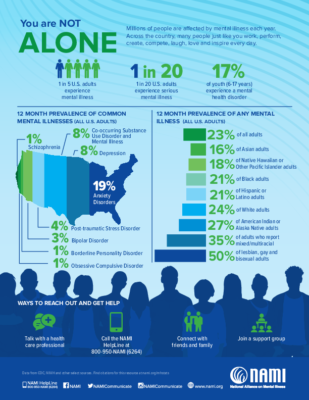 According to the Commonwealth Fund, in 2016, spending in the US on behavioral healthcare was almost $160 billion, with 58 percent of all behavioral health spending being paid for by Medicare and Medicaid. According to SAMHSA, The Substance Abuse and Mental Health Services Administration, Medicaid is the largest payer in the United States for behavioral health services. Medicaid accounted for 26 percent of all behavioral health spending in 2009. Behavioral health is a term for mental health and substance use disorder conditions to differentiate from physical health. As a clinician, I seldom met a person with chronic physical health issues who didn’t also have behavioral health issues. I don’t know how meaningful statistics are, except to say a lot of people have behavioral health diagnoses in their records. It costs them, their families, and communities a fortune, and government health insurance pays a significant proportion of those direct costs.
According to the Commonwealth Fund, in 2016, spending in the US on behavioral healthcare was almost $160 billion, with 58 percent of all behavioral health spending being paid for by Medicare and Medicaid. According to SAMHSA, The Substance Abuse and Mental Health Services Administration, Medicaid is the largest payer in the United States for behavioral health services. Medicaid accounted for 26 percent of all behavioral health spending in 2009. Behavioral health is a term for mental health and substance use disorder conditions to differentiate from physical health. As a clinician, I seldom met a person with chronic physical health issues who didn’t also have behavioral health issues. I don’t know how meaningful statistics are, except to say a lot of people have behavioral health diagnoses in their records. It costs them, their families, and communities a fortune, and government health insurance pays a significant proportion of those direct costs.
Podcast intro
Welcome to Health Hats, the Podcast. I’m Danny van Leeuwen, a two-legged cisgender old white man of privilege who knows a little bit about a lot of healthcare and a lot about very little. We will listen and learn about what it takes to adjust to life’s realities in the awesome circus of healthcare. Let’s make some sense of all of this.
Meet Dr. Mike Herndon
Health Hats: I invited my friend and colleague, Dr. Mike Herndon, recently retired Chief Medical Officer for the Oklahoma Healthcare Authority, Medicaid, to chat with us about Emerging Adults with Mental Illness.
Mike, thank you so much for joining me.
Mike Herndon: You bet, Danny. Happy to be here.
Health Hats: Thank you. My friend, Dr. Mike Herndon, and I have done quite a bit together over the years, mainly through PCORI, the Patient-Centered Outcomes Research Institute. We sat on an advisory panel together, then you were appointed to the PCORI Board of Governors, and I came on the board a few years later. You were my Board orientation buddy and helped me navigate and reduce the shock of the experience. I appreciate it. Let’s just jump right in. Mike, when did you first realize that health was fragile?
Health is Fragile
Mike Herndon: That’s an easy answer for me. I grew up in rural Oklahoma. In the summer between my sixth and seventh-grade years, I was 12 years old, and my mom had a pituitary tumor. That hormonal gland in the brain had gotten so large it caused terrific headaches. She had double and blurred vision and had to have a craniotomy, and brain surgery, to remove the tumor. That set off many health problems in the family, with financial Issues following. The stress on the family, but also the stress in her life and the resulting kind of emotional and mental toll that it took on her and the family, was tremendous. Growing up in a lower socioeconomic environment compounded the devastation. I know some people have faced adverse childhood experiences much worse than that, but that’s an easy one for me. Danny did a, when I was 12 years old, having a mom with a life-threatening illness and a craniotomy and significant surgery with all the sequela that came after that. I was very aware that health was fragile.
Mental Illness in family practice
Health Hats: You’re a family practice doc. I understand you spent 20 years in practice as the medical director or a clinical doctor in a college health clinic. How did young adult mental illness present to you in those venues?
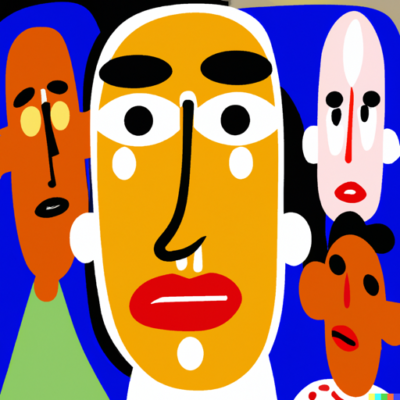
DALL.E Chosen family adults mixed race in Picasso style
Mike Herndon: To set the kind of frame of reference for that practice, I returned to the town of my alma mater to practice medicine. The university was looking for a campus doctor, so it was a way for me to build a practice. I visited the campus daily to see students as part of my practice. It was typically an hour’s commute to the health clinic. Then I went to my practice in the community. Everything, Danny, I can recall a patient with Asperger’s to people who just had simple test anxiety, situational depression, and then the spectrum in between. People who had depression, chronic depression, students, and undiagnosed until they left home. Some of that is situational from severe family dysfunction, some genuinely genetic and with an actual chemical imbalance, creating depression.
And then just the vast spectrum of navigating being out of the home, out of your sphere of friends and influence into a new environment, trying to make your way and develop your identity—and so just the stresses of that and the acting out. So, I would include some substance abuse issues.
Quite a range.
Readiness to manage mental illness in practice.
Health Hats: Did you mostly feel like you, did you feel prepared or adequate or that you could be helpful or were, you like, always looking for what services they need and that you couldn’t provide and, look for that? What, how, and what was your comfort with dealing with that?
Mike Herndon: Another great question. I think physicians all have their areas of interest. They develop expertise because of that interest. And indeed, one of my areas of interest was depression, anxiety, and mental health, primarily because of my childhood experience and my family experience. My family, my family has a history of depression. I understood it, I think, and I sought to understand it. In medical school, I paid much attention to behavioral health rotations. I’ve paid particular attention but also read and studied a lot. I understood the actual physiology and the neurochemistry of depression. And how life factors can play into that, but there can also be an underlying disturbance or an imbalance of those neurotransmitter chemicals: serotonin, norepinephrine, and dopamine. I had a basic understanding of that, which was very useful. So, I felt well equipped personally to prescribe antidepressants when appropriate. And to know when it was something that simply needed someone with the skillset to counsel them. I am very fortunate to have a Ph.D. psychologist on the staff, part-time at the university, who taught at the university but also was a provider in the clinic where I worked. So, we had a solid connection that I could use the health counseling center attached to the medical center. We worked collaboratively and beautifully together.
Over the years, we had a couple of different providers as that clinic grew. At one time, we had two counselors, and this is a college community of around with an enrollment of approximately 2000 students—part of the knack of being a good family doctor and treating behavioral health conditions, knowing when. I was always aware of my limitations. When it was beyond something, someone just needed some encouragement, understanding, and a listening ear, and my skillset was not adequate when they had some deeper issues. In my practice, I also developed a network of different types of counselors, LPCs (licensed alcohol and drug counselors), and people with PhDs in religious studies that were also counselors sometimes. It’s helpful. And then, of course, the psychiatrists and psychologists. I work to develop that network, that array, that scope. I also used that outside of the student health center. But man, what an absolute gift to have someone on campus with me to help. It was a great relationship, and it worked. It worked well.
State Medicaid Director
Health Hats: Then you went from private practice to being the State Medicaid Medical Director. Goodness. You went from the firing pan to the fire, but I’m not sure that’s a good metaphor. How did that happen?
Mike Herndon: To answer that, you must understand why a person would do that and be interested in that type of work and career shift. For me, 20 years of practicing medicine and what I believe to be the right way where you were the medical home, you took care of your patients. You may have heard me say this before, Danny, in some of our meetings, that I think the healthcare system right now is not designed to pay physicians to take care of people. The system’s designed to pay physicians to see patients. There’s a difference between caring for and seeing a patient. I took good care of my patients, but it took a toll on me. And after 20 years of that, I was pretty worn out.
I became interested in administrative medicine and had some friends who had an interest in administrative medicine and did some on a part-time basis. An opening came up at the State Medicaid agency, and I knew the chief medical officer, the state Medicaid director. I inquired about the position, and she said, Mike, I think you’d be an excellent fit for this. You need to apply. So, I applied, and with my background in primary care and all, I interviewed and was selected. So, I became a medical director and stayed in the medical director role for those first ten years or so. You do many things in Medicaid and help build care coordination and disease management programs. You also look at many medical records for quality concerns and appropriate billing. And just there’s an array of things that a doctor who takes on an administrative role for insurance companies does. You write policies, et cetera. So, I enjoyed that a lot, and it was just a career change that just happened for me.
Then, after ten years, I became the Chief Medical Officer for the State Medicaid program. With that came much more responsibility and leading a team of approximately 80 people in the agency to take care of the dental program, the medical program, what we covered, what we didn’t cover, and all sorts of significant decisions.
Levers of power

DALL·E 2023-06-10 09.54.04 – Levers of power as a watercolor
Health Hats: I imagine that your passion for mental health, although your role was broader than that, I think that your passion for mental health allowed you to apply what you learned in private practice and college health to this policy-payer world. So, what did you find in that role? In a way, wow, what an opportunity. You have a very different kind of power in that role. But as you and I have talked about together, when we talk about our position on the board of PCORI, power’s pretty specific, and it’s not all it’s cracked up to be. You must be mindful. What is power? What are the levers that I can pull? How did you use that role to affect systems instead of working with individuals?
Mike Herndon: Another great question and a very insightful question. First, I worked well with the Oklahoma State Department of Mental Health and Substance Abuse Services under different leadership. They were a sister agency, so we worked collaboratively on several projects. You must have that relationship between Medicaid and mental health and substance abuse programs. Because just to say we’re going to cover this, we’re going to cover that, is insufficient. I worked to develop that relationship and had an excellent relationship. The leadership at the Department of Mental Health and Medicaid had mutual respect. I spent much of my day during my ten years as a medical director looking at medical records. I just was very disturbed by the lack of integration of behavioral health and the care that people with mental health received. I would see people on anywhere from an antidepressant to inappropriate use of benzodiazepines to inappropriate use of antipsychotics, especially atypical antipsychotics that were very popular and yet no therapy yet, no behavioral health screen protocols. It was disturbing, to be brutally honest. We worked to establish some incentives, if you will, to incorporate behavioral health screening.
Aligning incentives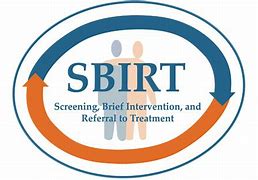
Mike Herndon: As a state-run program, we were not a managed care Medicaid state. We designed our delivery system, and we paid our primary care providers not just a fee-for-service, but also pay them some incentives to do certain things. It was primary care program-based program. And one of the things that we incentivized them for was to implement the SBIRT tool, Screening, Brief Intervention, and Referral Tool for therapy. It’s what S B I R T stands for. It is a billable service for providers in addition to seeing them, just like if you went to the doctor and the doctor took off a skin lesion. You may bill for the encounter and bill for the procedure. The expert code for SBIRT was something you could build in addition to evaluation management or the office visit code. So, we incentivized providers and said, Hey there, do this. And we even helped design a tool and told providers, please screen their patients, and when they do, you can bill us. So, we started that program. It was an incentive-based program hoping to kickstart behavioral health integration into physical health within our primary care network. We collaborated with the Department of Mental Health on that, by the way. And they were a driving force to help us. And, of course, as a medical director, I got to speak heavily about what we covered and didn’t cover for Medicaid. And there were lots of CPT codes, which is the textbook that, not text, but it is a book that all billable services to an insurer, that’s the code book that you use, and you put a specific code down based upon what service you deliver. And so, SBIRT had its own unique CPT code and two different types of SBIRT codes. One for more advanced services and one for more screening services. We implemented that. And the Department of Mental Health was instrumental in encouraging us to start covering that. We listened and participated in the conversation and decided to cover it as a state Medicaid agency. We want to go the next step and incentivize providers. So, we attempted that.
Health Hats: You could do that because you were in this position of influence and could coordinate that.
Mike Herndon: To answer your question, that was an important role I could play in helping to address this integration of behavioral health.
Minor success, at best
Health Hats: And so, how’d it go? Did you feel like there was more integration?
Mike Herndon: Overall, Danny, I would say it was a minor success and somewhat disappointing. At its worst, it was something providers saw to make an extra dollar, and they would do the minimum it took to be able to bill and get paid extra money. They would have their office staff screen with the screening instrument. The provider would pay very little attention to it. They did just enough to justify getting paid but did not truly integrate. That’s at its worst. And we have, unfortunately, some providers who are interested in seeing patients and not taking care of patients. And I think that type of provider somewhat took advantage of. And at its best, I believe providers went, this is what we’ve always sought. Wow. This is a great tool. I wished I’d have had this earlier. And they implemented it. They built their network with referrals. They had people they could because once they did the screen, the brief intervention: I’m here to help you. What can I do to help you? Something like, just as simple as that, and the patient certainly has a choice to say, this provider wants to help me, or I’m just not ready. If the patient says, wow, someone cares, they will help me. Then it’s on the provider and that team within that practice to get you to that next step of care. And that’s what SBIRT is about. It’s about referring to therapy. It’s not necessarily about doing the care right then. And so, I think providers, at its best, were thankful they learned and accepted it.
And then again, there was a spectrum of acceptance in between. People tried it and said, this is too much work. It’s put too much stress on my staff. I’m sorry I’m out on this. It’s not worth the incentive. And then some providers simply knew up front this was going to stress my practice out. It’s disrupting my workflow. I’m not interested. And they never adopted it. So, we had people all along that spectrum. And overall, did it have the uptake we wanted? No. It didn’t. It was an attempt, and I think some good came from it. I think we created a lot of awareness. Still, again, when I go back to that underlying principle of the reimbursement system in healthcare, it does not incentivize providers to take care of the patient.
It incentivizes providers to see patients and perform services, not care for them. So, I think it was almost a setup for failure. But occasionally, find a provider with the heart to do the right thing. And I think it was beneficial for that type of provider.
A word from our sponsor, Abridge
Now a word about our sponsor, ABridge. Record your healthcare conversations with doctors and other clinicians with ABridge. Push the big pink button and record. Read the transcript or listen to clips when you get home. Check out the app at ABridge.com or download it from the Apple app store or Google Play store. Let me know how it went.
Call to action
I need help. I’ve expanded my podcast this year to include video, and costs have surged to $15,000 annually, while each episode takes 30 to 40 hours to produce. With growing content and shrinking bandwidth, I need support to keep creating without impacting our retirement funds.
As I look towards the next 5-10 years, I’m building a production team of emerging adults to carry this project forward. This succession planning requires resources. But here’s the deal: you can help.
Visit health-hats.com/support for ways to contribute. Best option? Patreon offers a monthly subscription with bonus content, Zoom meetings with me and fellow contributors, personal Bari Sax MP3s, coaching sessions, and more.
Occasional donations are welcome, and you can still subscribe for free to enjoy bonus episodes. You can also recommend us through email, social media, or postcard – postage on us! Visit health-hats.com/support. Your support is deeply appreciated. Thank you.
Family Advocacy

getty-images-DFKlg_AuEGE-unsplash
Health Hats: If you look back on your different roles. I want to think specifically about young adults with mental illness. If you were a queen for a day and you could wave your magic wand, and you could have done something in one of these roles that would’ve helped young adults and their families find better or best health that’s more manageable and sustainable. What would you like to see that you think would have an impact?
Mike Herndon: My answer may surprise you, but it may not. I think it would be family education. To educate parents on how to recognize and be an advocate for their child. It goes from understanding mental illness as a medical condition, not a mental illness. When I grew up, mental illness was something you dreaded hearing anyone say about anyone because it automatically meant, quote, they’re crazy, right? To dispel old stigma and get parents into the new age of realizing that brain chemistry is no different from pancreas chemistry. A person with an imbalance of the hormones in the pancreas can develop diabetic hypoglycemia. And people with an imbalance of brain chemistry can have a behavioral or mental health diagnosis, so educate the family on the appropriateness of reaching out and destigmatizing. We’ve had lots and lots of conversations and media campaigns and things about that, and I think we’re getting, but then secondly, to recognize and your child what typical post-adolescent, teen, and young adult typical behaviors are.
What do you do if you suspect it? How do you become an advocate? And I think many parents just think, look, I did my best. When they leave home, go to college, or move out and get an apartment, they’re on their own. And we don’t prepare our Children in their formative years, preadolescents, and adolescents to understand behavioral health.
And I’ll share a personal story with me. I have an adult daughter whose Ph.D. trained. She’s incredibly gifted and very bright, and in high school had a significant struggle And I won’t say, see, it was no different than her peers. But it was she was experiencing stress and some situational depression. And we talked about that, and I was able, given her Intellect and eagerness, to learn. I’d draw her a diagram of how neurotransmitters in the brain work, how stress can disrupt them, and how this made sense to her. And she went, ah, I get it. And literally, so we started working on that with just understanding was the key. And for her to know that Dad gets it and he’s here for me.
Health Hats: And he loves me. And we’re going to tackle this together.
Mike Herndon: You’re right. And I think my magic wand would be to wave over parents and say, please be an advocate and help your child. Yeah. And it starts here, but if you didn’t get it back in those formative years, at least be willing to reach out and help them. Because those years are tough, when you leave home, and you’re suddenly thrust into this world, you start making decisions, and if you have underlying behavioral health issues, they will be magnified. So, I think the magic one would be prepare your child. And don’t quit advocating for them just because they leave the house. Now, there’s a point in time we all understand when adults become adults, but there is a period when they still need us. Yeah. And young adulthood is one of those.
Health Hats: What should we have discussed that we haven’t about young adults and mental illness?
Not easy being an emerging adult
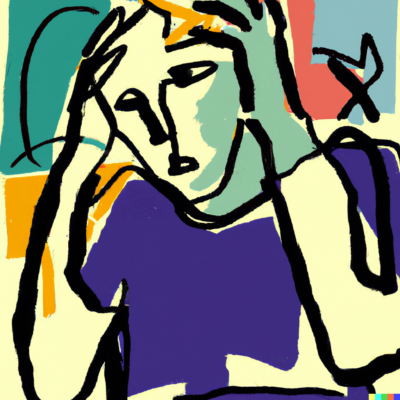
Created by DALL.E 2022-12-20 14.54.00 – Matisse-like image of young adult with mental illness
Mike Herndon: When young adults experience traumas and stresses, they look for ways to deal with them. Unfortunately, substance abuse is a frequent coping skill to look for alcohol, to look for drugs, and other inappropriate behaviors can treat. Understanding mental health’s role and simple non-psychosis issues can lead to that. I think the other thing is just an awareness of social media and the current stressors that young adults face. I don’t think, again, we need to explain that, but the suicide rate, drug overdoses, and things that are impacted mainly by social media and negativity and feeling of inadequacy, and it just breaks my heart every time you hear of one of those. But it is a reality that we live in. And the societal pressures, including social media, keeping up with the Kardashians, and fortunately, we’re getting away from some of this body image and shaming that has gone on in acceptance of the bodies in which we live and exist, and accepting those. And I think for providers to be aware of and accept some responsibility for helping young adults, people, and late teens navigate that transition to young adulthood to be mindful of what it takes in this generation because it was in our generation. It just wasn’t the same. Just face it, and it won’t be the same for them, the generation that’s now transitioning. Providers need to be intensely aware of their patient’s environment and what they live in and be ready to assist however they can. So, if we missed something, that would probably be Danny, just to cover that. It’s not easy to be a young adult, especially a single young adult. In today’s environment, it just isn’t. Trying to equip our young adults as they leave home, I think, is a tremendous job. The parents and the family community need to do a better job. I guess I was saying that’s that magic wand if I could enhance the family’s capabilities and abilities to prepare their young adults. And we haven’t spent much time on severe mental illness, but that’s it. It’s the same with severe mental illness. It’s a different set of treatment strategies. And we indeed, and those can stress the family, and families are much more in tune with behavioral health issues when they have a child with that. I think the families tend to ignore and don’t want to respect the stressors and the impact behavioral health impact it can have on seemingly unaffected young adults, and we’re all affected. It’s just our coping skills and to what degree life prepared us.
Health Hats: Thank you. I appreciate you taking this time with me. I have to process. You said a lot. Thank you very much for taking the time. I’m glad you were where you were.
Mike Herndon: I appreciate that. Thank you. We would all like to hope that we left this world a little better than it was when we came into it, right?
Health Hats: I agree. All right, man. Thank you. Talk to you soon.
Reflection
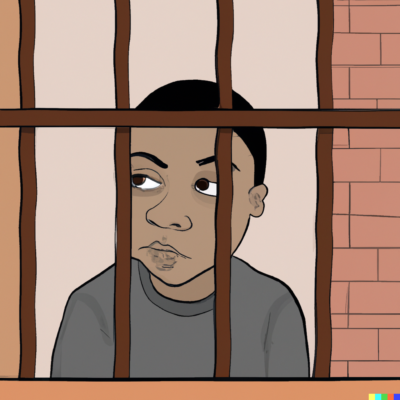
DALL·E 2023-06-10 09.50.44 – Cogs stuck as a black and white photo
A mother contacted me this week with a harrowing tale of two weeks in a community emergency department with her emerging adult son in crisis waiting for an adolescent psych inpatient bed. The two weeks felt like solitary confinement, never outside, with no windows, and much of the time in hallways without TV, iPad, or any stimulation. To add insult to injury, the hospital fed him grilled cheese sandwiches twice daily when he was lactose intolerant and refused to allow her to bring in home-cooked food. I remind us that policy, culture, bureaucracy, and staffing have real-life implications. It’s too raw for this mother to tell her story publicly, but you will hear it in the next year.
As you know from this series and this episode, good people struggle with an insane system. It’s not like this doesn’t have solutions, but our national priorities and incentives prevent much change. OK, that’s the rant.
I appreciate that Dr. Herndon took the time and provided some insight into his attempts to affect policy change. He used his levers of power to affect change: create a payer code for screening that had a seriously underwhelming response. Sadly, this episode depressed me. Glad I’m not an emerging adult needing treatment.
I have four more episodes in this series for you for a total of fifteen episodes: two researchers, one health economist, and a wrap-up/summary from me. I will try to end with something uplifting.
Podcast Outro
I host, write, edit, engineer, and produce Health Hats, the Podcast. Kayla Nelson provides website and social media consultation and manages dissemination. Leon van Leeuwen edits the article-grade transcript. Joey van Leeuwen supplies musical support, especially for the podcast intro and outro. I play bari sax on some episodes alone or with the Lechuga Fresca Latin Band. I’m grateful to you, who have the most critical roles as listeners, readers, and watchers. See the show notes, previous podcasts, and other resources through my website, www.health-hats.com, and YouTube channel. Please subscribe and contribute. If you like it, share it. See you around the block.
Episode Notes
Please comment and ask questions
- at the comment section at the bottom of the show notes
- on LinkedIn
- via email
- YouTube channel
- DM on Instagram, Twitter, Mastadon to @healthhats
Production Team
Web and Social Media Coach, Dissemination Kayla Nelson @lifeoflesion
Leon van Leeuwen edits the article-grade transcript.
Music on intro and outro by permission from Joey van Leeuwen, Drummer, Composer, and Arranger including Moe’s Blues for Proem and Reflection
Other Credits
Images
Vulture Couple by Rich Rieger used with permission
Woman and clown by Diana Feil on Unsplash
DALL.E “Chosen family mixed race Picasso style
DALL·E 2023-06-10 09.54.04 – Levers of power as a watercolor
DALL·E 2022-12-20 14.54.00 – Matisse-like image of young adult with mental illness
:DALL·E 2023-06-10 09.46.37 – An adolescent boy of color in solitary confinement as a cartoon
SBIRT by https://prevention.iu.edu/services/ta.php
Magic wand by getty-images-DFKlg_AuEGE-unsplash
Disclaimer
The views and opinions presented in this podcast and publication are solely my responsibility and do not necessarily represent the views of the Patient-Centered Outcomes Research Institute® (PCORI®), its Board of Governors, or Methodology Committee. Danny van Leeuwen (Health Hats)
Sponsored by Abridge
Inspired by and grateful to Nakela Cook, Amanda Chue, Andrea Condit, Laura Zucker
Links
Mental Health By the Numbers | NAMI: National Alliance on Mental Illness
SAMHSA, The Substance Abuse and Mental Health Services Administration, statistics
Dr. Mike Herndon bio
Oklahoma State Department of Mental Health and Substance Abuse Services
Related podcasts
Series: Pediatric Transition to Adult Care
Creative Commons Licensing
The material found on this website created by me is Open Source and licensed under Creative Commons Attribution. Anyone may use the material (written, audio, or video) freely at no charge. Please cite the source as: ‘From Danny van Leeuwen, Health Hats. (including the link to my website). I welcome edits and improvements. Please let me know. danny@health-hats.com. The material on this site created by others is theirs, and use follows their guidelines.
